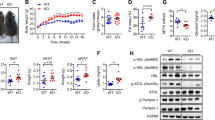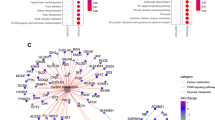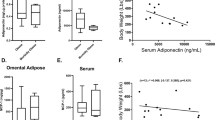Abstract
Objective:
To examine the expression of selected transcription factors involved in adipogenesis and genes related to lipid metabolism in abdominal subcutaneous and omental fat tissue.
Research design and methods:
We obtained subcutaneous and omental adipose tissue samples from 40 women undergoing abdominal hysterectomies (age: 47±5 years; BMI 27.9±5.3 kg/m2). We measured isolated adipocyte size and metabolism, and detailed measures of body fat accumulation and body fat distribution were obtained (dual-energy X-ray absorptiometry and computed tomography, respectively).
Results:
Adipocyte size of both subcutaneous and omental fat were increased with higher body fat mass values, with similar regression slopes in each compartment. In contrast, with higher body fat mass values, fat accumulation was progressively higher in the subcutaneous than in the visceral fat compartment, suggesting hyperplasia in the subcutaneous fat compartment. Messenger RNA levels of CEBPα, PPARγ2, SREBP1c and genes related to lipid metabolism (LPL, FABP4, DGAT1, DGAT2, PLIN and HSL) were significantly higher in subcutaneous than in omental fat tissue (P⩽0.001 for all). Only subcutaneous expression of these genes tracked with obesity levels as reflected by significant positive associations between subcutaneous fat CEBPα, SREBP1c and DGAT2 expression and total body fat mass (r=0.37, r=0.41, r=0.57, respectively, P⩽0,05), fat percentage (r=0.40, r=0.39, r=058, respectively, P⩽0,05) and subcutaneous adipose tissue area (r=0.36, r=0.38, r=0.58, respectively, P⩽0,05). Omental adipose tissue expression levels of these genes were not significantly related to adiposity measures.
Conclusions:
These results show that in obese women, hyperplasia is predominant in the subcutaneous fat depot, whereas fat cell hypertrophy is observed both in the omental and subcutaneous compartments.
This is a preview of subscription content, access via your institution
Access options
Subscribe to this journal
Receive 12 print issues and online access
$259.00 per year
only $21.58 per issue
Buy this article
- Purchase on Springer Link
- Instant access to full article PDF
Prices may be subject to local taxes which are calculated during checkout



Similar content being viewed by others
References
Despres JP, Moorjani S, Lupien PJ, Tremblay A, Nadeau A, Bouchard C . Regional distribution of body fat, plasma lipoproteins, and cardiovascular disease. Arteriosclerosis 1990; 10/4: 497–511.
Wajchenberg BL . Subcutaneous and visceral adipose tissue: their relation to the metabolic syndrome. Endocr Rev 2000; 21/6: 697–738.
Tchernof A, Belanger C, Morisset AS, Richard C, Mailloux J, Laberge P et al. Regional differences in adipose tissue metabolism in women—minor effect of obesity and body fat distribution. Diabetes 2006; 55/5: 1353–1360.
Boivin A, Brochu G, Marceau S, Marceau P, Hould F-S, Tchernof A . Regional differences in adipose tissue metabolism in obese men. Metabolism 2007; 56/4: 533–540.
Cao Z, Umek RM, McKnight SL . Regulated expression of three C/EBP isoforms during adipose conversion of 3T3-L1 cells. Genes Dev 1991; 5/9: 1538–1552.
Yeh WC, Cao Z, Classon M, McKnight SL . Cascade regulation of terminal adipocyte differentiation by three members of the C/EBP family of leucine zipper proteins. Genes Dev 1995; 9/2: 168–181.
Rosen ED, Hsu CH, Wang X, Sakai S, Freeman MW, Gonzalez FJ et al. C/EBPalpha induces adipogenesis through PPARgamma: a unified pathway. Genes Dev 2002; 16/1: 22–26.
Lazar MA . PPAR gamma, 10 years later. Biochimie 2005; 87/1: 9–13.
Tontonoz P, Hu E, Spiegelman BM . Stimulation of adipogenesis in fibroblasts by PPAR gamma 2, a lipid-activated transcription factor. Cell 1994; 79/7: 1147–1156.
Auwerx J . PPARgamma, the ultimate thrifty gene. Diabetologia 1999; 42/9: 1033–1049.
Giusti V, Verdumo C, Suter M, Gaillard RC, Burckhardt P, Pralong F . Expression of peroxisome proliferator-activated receptor-gamma1 and peroxisome proliferator-activated receptor-gamma2 in visceral and subcutaneous adipose tissue of obese women. Diabetes 2003; 52/7: 1673–1676.
Lefebvre AM, Laville M, Vega N, Riou JP, van Gaal L, Auwerx J et al. Depot-specific differences in adipose tissue gene expression in lean and obese subjects. Diabetes 1998; 47/1: 98–103.
Sewter C, Blows F, Considine R, Vidal-Puig A, O'Rahilly S . Differential effects of adiposity on peroxisomal proliferator-activated receptor gamma1 and gamma2 messenger ribonucleic acid expression in human adipocytes. J Clin Endocrinol Metab 2002; 87/9: 4203–4207.
Kim JB, Spiegelman BM . ADD1/SREBP1 promotes adipocyte differentiation and gene expression linked to fatty acid metabolism. Genes Dev 1996; 10/9: 1096–1107.
Fajas L, Schoonjans K, Gelman L, Kim JB, Najib J, Martin G et al. Regulation of peroxisome proliferator-activated receptor gamma expression by adipocyte differentiation and determination factor 1/sterol regulatory element binding protein 1: implications for adipocyte differentiation and metabolism. Mol Cell Biol 1999; 19/8: 5495–5503.
Deschenes D, Couture P, Dupont P, Tchernof A . Subdivision of the subcutaneous adipose tissue compartment and lipid-lipoprotein levels in women. Obes Res 2003; 11/3: 469–476.
Moorjani S, Dupont A, Labrie F, Lupien PJ, Brun D, Gagne C et al. Increase in plasma high-density lipoprotein concentration following complete androgen blockage in men with prostatic carcinoma. Metabolism 1987; 36/3: 244–250.
Gidez LI, Miller GJ, Burstein M, Slagle S, Eder HA . Separation and quantitation of subclasses of human plasma high density lipoproteins by a simple precipitation procedure. J Lipid Res 1982; 23/8: 1206–1223.
Laurell CB . Quantitative estimation of proteins by electrophoresis in agarose gel containing antibodies. Anal Biochem 1966; 15: 45–52.
Rodbell N . Metabolism of isolated fat cells. J Biol Chem 1964; 239: 375–380.
Kather H, Schroder F, Simon B . Micro-determination of glycerol using bacterial nadh-linked luciferase. Clin Chim Acta 1982; 120/3: 295–300.
Taskinen MR, Nikkila EA, Huttunen JK, Hilden H . A micromethod for assay of lipoprotein-lipase activity in needle-biopsy samples of human adipose-tissue and skeletal-muscle. Clin Chim Acta 1980; 104/1: 107–117.
Bjorntorp P . Adipose-tissue distribution and function. Int J Obes 1991; 15: 67–81.
Tchkonia T, Tchoukalova YD, Giorgadze N, Pirtskhalava T, Karagiannides I, Forse RA et al. Abundance of two human preadipocyte subtypes with distinct capacities for replication, adipogenesis, and apoptosis varies among fat depots. Am J Physiol Endocrinol Metab 2005; 288/1: E267–E277.
Tchoukalova Y, Koutsari C, Jensen M . Committed subcutaneous preadipocytes are reduced in human obesity. Diabetologia 2007; 50/1: 151–157.
Tchoukalova YD, Sarr MG, Jensen MD . Measuring committed preadipocytes in human adipose tissue from severely obese patients by using adipocyte fatty acid binding protein. Am J Physiol Regul Integr Comp Physiol 2004; 287/5: R1132–R1140.
Giusti V, Suter M, Verdumo C, Gaillard RC, Burckhardt P, Pralong FP . Molecular determinants of human adipose tissue: differences between visceral and subcutaneous compartments in obese women. J Clin Endocrinol Metab 2004; 89/3: 1379–1384.
Adams M, Montague CT, Prins JB, Holder JC, Smith SA, Sanders L et al. Activators of peroxisome proliferator-activated receptor gamma have depot-specific effects on human preadipocyte differentiation. J Clin Invest 1997; 100/12: 3149–3153.
Montague CT, Prins JB, Sanders L, Zhang JL, Sewter CP, Digby J et al. Depot-related gene expression in human subcutaneous and omental adipocytes. Diabetes 1998; 47/9: 1384–1391.
Tchkonia T, Lenburg M, Thomou T, Giorgadze N, Frampton G, Pirtskhalava T et al. Identification of depot-specific human fat cell progenitors through distinct expression profiles and developmental gene patterns. Am J Physiol Endocrinol Metab 2007; 292/1: E298–E307.
Vohl MC, Sladek R, Robitaille J, Gurd S, Marceau P, Richard D et al. A survey of genes differentially expressed in subcutaneous and visceral adipose tissue in men. Obes Res 2004; 12/8: 1217–1222.
Gray SL, Nora ED, Vidal-Puig AJ . Mouse models of PPAR-gamma deficiency: dissecting PPAR-gamma's role in metabolic homoeostasis. Biochem Soc Trans 2005; 33: 1053–1058.
Abbasi F, Chang SA, Chu JW, Ciaraldi TP, Lamendola C, McLaughlin T et al. Improvements in insulin resistance with weight loss, in contrast to rosiglitazone, are not associated with changes in plasma adiponectin or adiponectin multimeric complexes. Am J Physiol Regul Integr Comp Physiol 2006; 290/1: R139–R144.
Yang WS, Jeng CY, Wu TJ, Tanaka S, Funahashi T, Matsuzawa Y et al. Synthetic peroxisome proliferator-activated receptor-gamma agonist, rosiglitazone, increases plasma levels of adiponectin in type 2 diabetic patients. Diabetes Care 2002; 25/2: 376–380.
Cancello R, Tordjman J, Poitou C, Guilhem G, Bouillot JL, Hugol D et al. Increased infiltration of macrophages in omental adipose tissue is associated with marked hepatic lesions in morbid human obesity. Diabetes 2006; 55/6: 1554–1561.
Harman-Boehm I, Blüher M, Redel H, Sion-Vardy N, Ovadia S, Avinoach E et al. Macrophage infiltration into omental versus subcutaneous fat across different populations: effects of regional adiposity and the co-morbidities of obesity. J Clin Endocrinol Metab 2007; 92/6: 2240–2247.
Sniderman AD, Bhopal R, Prabhakaran D, arrafzadegan D, chernof A . Why might South Asians be so susceptible to central obesity and its atherogenic consequences? The Adipose Tissue Compartment Overflow Hypothesis. Int J Epidemiol 2007; 36/1: 220–225.
Smith J, Al Amri M, Dorairaj P, Sniderman A . The adipocyte life cycle hypothesis. Clin Sci 2006; 110/1: 1–9.
Johnson D, Dixon AK, Abrahams PH . The abdominal subcutaneous tissue: computed tomographic, magnetic resonance, and anatomical observations. Clin Anat 1996; 9: 19–24.
Markman B, Barton Jr FE . Anatomy of the subcutaneous tissue of the trunk and lower extremity. Plast Reconstr Surg 1987; 80/2: 248–254.
Acknowledgements
This study was supported by operating funds from the Canadian Institutes of Health Research—Institute of Gender and Health to André Tchernof (MOP-64182). The contribution of Drs Pierre Dupont, Marleen Daris, Philippe Laberge, Suzanne Noël, Jacques Morency, Denis Légaré, Céline Bouchard and Johanne Hurtubise is gratefully acknowledged. We acknowledge the invaluable help of nurses from the outpatient care unit and of radiology technicians. Expression measurements were performed by the Gene Quantification core laboratory of the Centre de Génomique de Québec. We thank all women who participated in the study for their excellent collaboration.
Author information
Authors and Affiliations
Corresponding author
Rights and permissions
About this article
Cite this article
Drolet, R., Richard, C., Sniderman, A. et al. Hypertrophy and hyperplasia of abdominal adipose tissues in women. Int J Obes 32, 283–291 (2008). https://doi.org/10.1038/sj.ijo.0803708
Received:
Revised:
Accepted:
Published:
Issue Date:
DOI: https://doi.org/10.1038/sj.ijo.0803708
Keywords
This article is cited by
-
Sexual dimorphism in cardiometabolic health: the role of adipose tissue, muscle and liver
Nature Reviews Endocrinology (2021)
-
Dysmetabolic adipose tissue in obesity: morphological and functional characteristics of adipose stem cells and mature adipocytes in healthy and unhealthy obese subjects
Journal of Endocrinological Investigation (2021)
-
Expression profiling and analysis of some miRNAs in subcutaneous white adipose tissue during development of obesity
Genes & Nutrition (2020)
-
Adipose Morphology: a Critical Factor in Regulation of Human Metabolic Diseases and Adipose Tissue Dysfunction
Obesity Surgery (2020)
-
Resistin Mediates Sex-Dependent Effects of Perivascular Adipose Tissue on Vascular Function in the Shrsp
Scientific Reports (2019)



